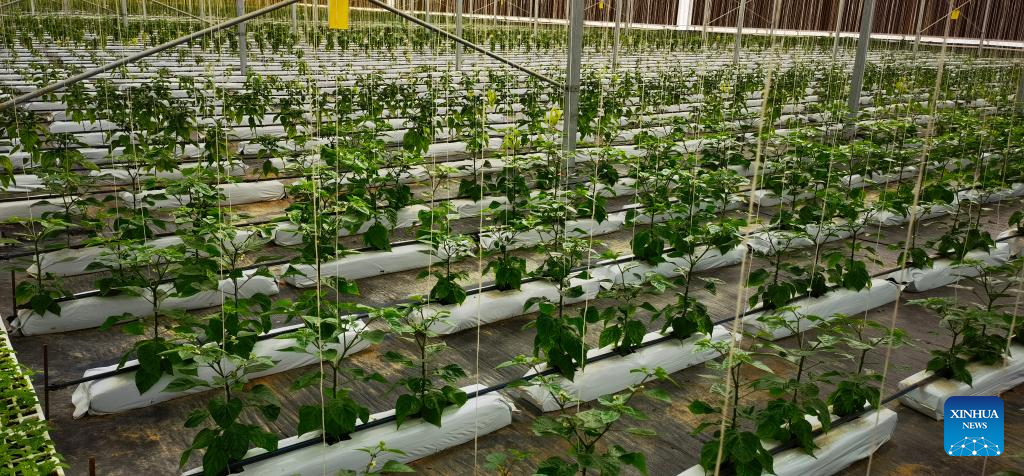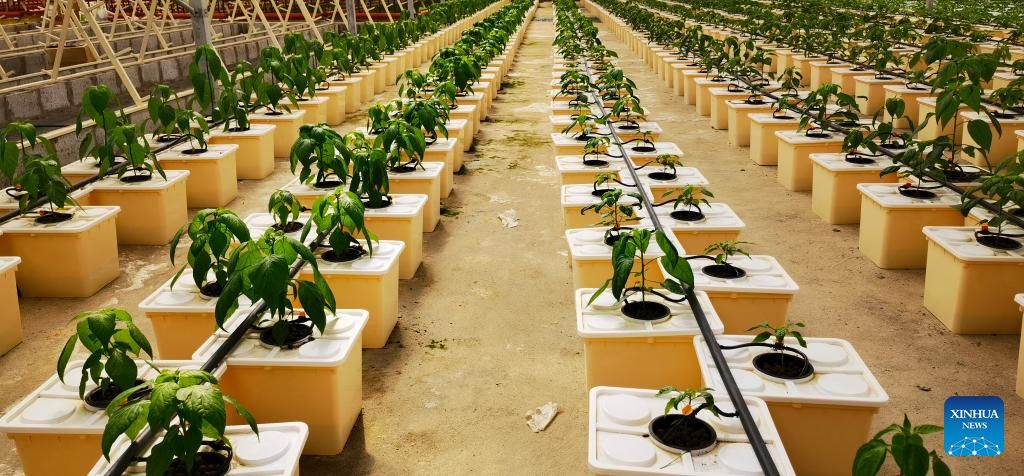
This photo taken with a mobile phone shows vegetables growing in a greenhouse in a desert in north Qatar Nov. 17, 2022. (The Institute of Urban Agriculture/Handout via Xinhua)
BEIJING, April 18 (Xinhua) -- Against the backdrop of the desert outside Doha, capital of Qatar, several large vegetable greenhouses stand out like an oasis.
Those are not just any vegetable greenhouses.
The vegetables there are not grown in the field, but in soilless multi-layered containers. Each row of growing vegetables is equipped with a tube in which, instead of ordinary water, a nutrient solution is flowing for the vegetables to grow.
The vegetable greenhouses are a vivid example of how Chinese agricultural technology is helping to improve vegetable cultivation in countries along the Belt and Road Initiative (BRI), which was launched about ten years ago.
Located on the southwestern coast of the Persian Gulf, Qatar relies heavily on imported vegetables, meat and other agricultural products due to limited arable land and freshwater resources. Since the end of 2019, the Institute of Urban Agriculture (IUA) of the Chinese Academy of Agricultural Sciences (CAAS) has been providing advanced planting techniques to local agricultural companies in Qatar.
"We have been working with Qatar WeGrow Agriculture Investment WLL, helping local people develop new methods to breed vegetables that are adapted to the local environment," said Qi Zhiyong, a researcher at the IUA.
Growing vegetables in the arid desert is a huge challenge. Chinese experts have made special designs in the light, water and soil required for plant growth.
According to Qi, to avoid the strong sunlight in the desert, they have installed shaded greenhouses outside the plant breeding containers, and brought an LED light environment control technique to ensure the plants' need for light.
"Different plants need different types of light to grow. We have developed special LED light formulas for different vegetables as well as related equipment," Qi said.
In terms of the water and soil, the IUA experts have combined hydroponics and solid active fiber soil technique, or the Leitu technique.
"The latter replaces soil with an ecological material mainly made from straw, cotton stalks, and other agricultural and forestry wastes, ensuring a high output with low energy consumption," said Qi, also the founder of the Leitu technique.
Hydroponics mainly cultivates leafy vegetables, while the Leitu technique provides growing conditions for more varieties of vegetables such as eggplants, tomatoes, and cucumbers, Qi said.
"All these techniques have helped to achieve the standardized management of temperature, light, and humidity control in the process of vegetable growth," he added.
According to the IUA, China's technology has increased vegetable production in Qatar from two varieties three years ago to more than 30 varieties, including six types of lettuce, four types of collard, five types of peppers, cabbage, spinach, and celery.
"We have built over 10,000 square meters of vegetable greenhouses in Qatar and done a great job in supporting the supply of vegetables for the 2022 FIFA World Cup in Qatar," Yang Qichang, deputy director of the IUA.
Meanwhile, the IUA experts are working with the country's Hamad Bin Khalifa University to build a joint research laboratory. "We will soon send our first batch of technicians there to plant fruits such as strawberries and blueberries, which is quite a challenging attempt in the desert," Qi said.
"We aim to achieve an industry-university-research cooperation in desert plant cultivation," he added.
With the success of the planting model in Qatar, Chinese agricultural technology is welcomed by more countries along the BRI. Qi revealed that companies in the United Arab Emirates and Oman are hoping to cooperate with them in the near future to set up more smart vegetable greenhouses in the desert.
"We will bring our technology to benefit more countries along the BRI," Yang said. ■

This photo taken with a mobile phone shows vegetables growing in a greenhouse in a desert in north Qatar Nov. 17, 2022. (The Institute of Urban Agriculture/Handout via Xinhua)



